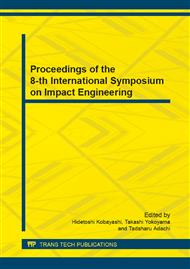p.128
p.134
p.140
p.146
p.152
p.158
p.167
p.173
p.179
Strain Rate Effects on Strain-Induced Martensitic Transformation and Electrical Resistivity of Deforming Stainless Steel
Abstract:
Austenitic stainless steel was compressed at a strain rates of 103 s-1 using a Hopkinson pressure bar apparatus at temperatures of 77 K and 293 K. The electrical resistivity was measured to determine the volume fraction of martensite of a deforming specimen. A compressive specimen of the dumbbell type was suitable for attaching the lead-in wires of four-point probes to the specimen. The volume fraction of martensite formed at a strain rate of 103 s-1 was lower than that formed at a low strain rate regardless of the temperature, and the effect of the strain rate on the electrical resistivity was slight. However, since the volume fraction of martensite is expressed as a linear function of the electrical resistivity ratio as well as in the results obtained by the tensile test, the electrical resistivity was available as an index for estimating the volume fraction of martensite induced by dynamic deformation. The duration of the input wave was approximately 150 μs, and the appearance of the peak value of transient resistivity was approximately 1ms after the arrival of the input wave at the specimen. These results showed that the structure change evaluated using electrical resistivity was not completed in the time required for the stress wave to pass through the specimen, although the electrical resistivity immediately after dynamic deformation closely approached that obtained by the static test.
Info:
Periodical:
Pages:
152-157
Citation:
Online since:
June 2014
Authors:
Price:
Сopyright:
© 2014 Trans Tech Publications Ltd. All Rights Reserved
Share:
Citation:


